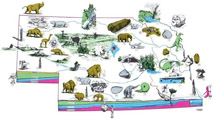Natural Resources, School of
Leaf Optical and Indirect LAI Measurements in Wheat and Alfalfa at MACIV: AgMet Progress Report 89-4
Date of this Version
1989
Document Type
Article
Citation
Walter-Shea, E.A., Blad, B.L. Leaf Optical and Indirect LAI Measurements in Wheat and Alfalfa at MACIV: AgMet Progress Report 89-4. Department of Agricultural Meteorology. Institute of Agriculture and Natural Resources. pp. 10.
Abstract
Interpretation of remotely sensed vegetative surfaces requires an understanding of the interaction of radiation with the various components of vegetation. Leaves are the most important component. Thus it is important to know the optical properties of individual leaves as well as the amount and distribution of leaves making up the vegetative cover. The objectives of our study were 1) to characterize the reflectance from and transmittance through adaxial and abaxial surfaces of individual wheat and alfalfa leaves and 2) to compare the traditional, time-consuming, destructive method of estimating LAI (direct method) to a relatively quick, indirect estimate of LAI in wheat and alfalfa. Measurements indicated little variation between reflectances of adaxial and abaxial leaf wheat surfaces nor between the leaves of plants from the irrigated and non-irrigated plots. Differences, however, were noted in transmittances, particularly in the NIR and mid-IR portions of the spectrum between leaf surfaces and irrigation treatments. Alfalfa leaf reflectance and transmittance properties varied slightly particularly in NIR and mid- IR portions of the spectrum, depending on the leaf surface. There was fairly good agreement between the direct and indirect estimates of LAI in wheat while large differences were found between estimates in alfalfa (the latter is attributed to the long delay in processing the alfalfa leaf material in the destructive method).
Included in
Biodiversity Commons, Natural Resource Economics Commons, Natural Resources and Conservation Commons, Natural Resources Management and Policy Commons, Other Environmental Sciences Commons, Terrestrial and Aquatic Ecology Commons, Water Resource Management Commons



Comments
OFR-253